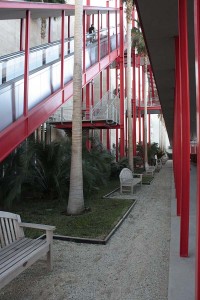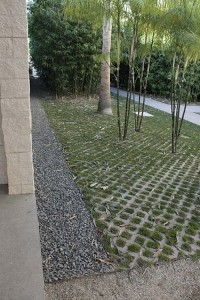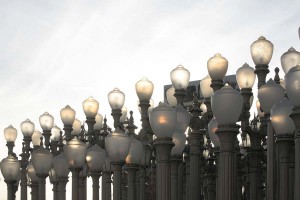Another quick stop over the holidays took the form of a visit to the Los Angeles County Museum of Art.
Installed at the new main entrance is this battalion of 202 antique streetlights, Urban Light, by artist Chris Burden. Streetlights like these of course were positioned at curbs in straight lines, spaced regularly. Clustering them together like this accentuates that fact, and to me makes the whole installation seem maybe just a little bit militaristic.
Arranged behind the Burden piece are some palm trees, the first plantings of what will be a large installation of palms by Robert Irwin. Irwin is the design force behind the Central Garden at the J. Paul Getty Museum, but here the trees will read less like a separate garden than plantings integrated into the art and architecture.
Their trunks echo the posts of the streetlights, as does the fact that they’re planted in a regular pattern. Also, as with the streetlights, they’re a collection of different kinds. A press release states: “Along with the palms, Irwin’s other medium is Southern California’s light, and the species of palms have been specially chosen to gather and reflect the interplay of light and shadow native to L.A.” [ source ] I love Robert Irwin’s work [ here’s a sample ], and I’ll be checking back on this installation as time goes on.
The whole vertical shaft thing becomes a theme around the Museum’s latest building, the newish Broad Contemporary Art Museum, which has red exterior accents, including plenty of red columns.
The landscaping in this part of the museum is interesting in that it uses palms or flat plantings. Virtually no shrubs. It’s a pretty urban planting that in part seems designed to give the homeless no place to camp.
Most horizontal surfaces, using decomposed granite or this Turfstone product, are designed as walkable extensions of the concrete paving. Where does the landscape end and the urban fabric begin?
Here’s an interesting gardening aside: The Museums are located on the same big city block as the famed La Brea Tar Pits, where the ground oozes black, gummy tar, a substance that has preserved bones of sabertooth tigers and woolly mammoths from the last ice age that got too close to the stuff. Just imagine trying to garden where digging a hole to plant a shrub might put you in contact with the deadly sludge! I have yet to pick up a garden book that even begins to discuss what to do with this kind of soil problem. While the park containing the tar pits has a few gooey shoe-grabbing spots, these plantings seemed free of the muck.
My main reason for visiting LACMA was to take in a photo exhibit that reassembles many of the works that were seen in the seminal 1975 “New Topographics” exhibition of landscape photography. These works in the show signaled a break from the more romantic takes on what landscape photos ought to look like and engaged a land where the human presence reigned supreme.

One of my favorite photographers in the show, Robert Adams, often combines the romantic sublime with a cooler take on what the world really looks like. To the left is “Mobile Homes, Jefferson County, Colorado” from 1973 [ source ], a great example of what his eye sees. You get the sense in his work that the human landscape often fails to live up to the stunning geography where it’s sited.
Seeing his work again prompted me to reread some of his Beauty in Photography: Essays in Defense of Traditional Values. (From this photo you can see that he takes “traditional values” pretty broadly.) Here’s a quick snippet gardeners and landscape designers might like to think about.
Not surprisingly, many photographers have loved gardens, those places that Leonard Woolf once described as “the last refuge of disillusion.” Gardens are in fact strikingly like landscape pictures, sanctuaries not from but of truth.
–from the essay, “Truth and Landscape” in Beauty in Photography
In parting, let me move from beauty in photography to beauty in art. Here’s a closeup of Urban Light, backlit by the afternoon sun:
(For another example of Burden’s work, check out the installation of 50,000 nickel coins and 50,000 matchsticks that the San Diego Museum of Contemporary Art exhibited: The Reason for the Neutron Bomb.)







